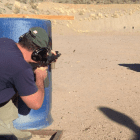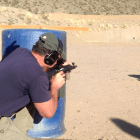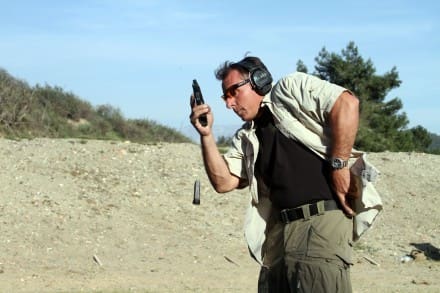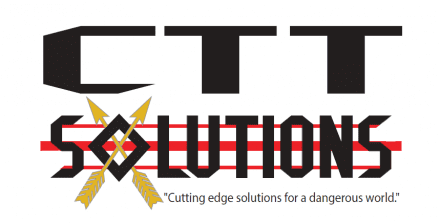Use of the safety on an M4
The debate is endless on whether or not the safety should be actuated on reloads, transitions or malfunctions. I use the selector every time I dismount the rifle from my shoulder without any time penalty and here is my take and the methodology behind it.
The selector is a crucial part of the rifle and I object when it is not being activated due to convenience. That said there is a simple method to learn it based on a simple methodology which is:
YOU INITIATE THE LARGEST MOTION OF DISMOUNTING THE RIFLE WITH THE SMALLEST AND MOST CRUCIAL MOTION OF INITIATING MOVEMENT OF THE THUMB TO ACTIVATE THE SELECTOR. (See the two pictures below. You can see my wrist break to operate the safety before the rifle has been dismounted and before the empty brass is still in the air.)
**Once I break my wrist and hook the selector with my thumb, the work is done. I begin the entire sequence by beginning to put the rifle on safe and they happen almost simultaneously and extremely seamlessly.**
I initiate dismounting the rifle by first initiating movement of my thumb toward the selector. By doing this I am certain not to forget to safe the rifle if there is any break in the continuity of the reload like retrieving a magazine from a closed pouch or if something draws my attention like another person talking to me or another minor event seizing my attention even for a moment. I have patterned my weapons manipulation to do this and so when I place the rifle on safe during the dismount I don’t consciously do or feel it. It is the right answer and so it is transparent during the reload. That said I have patterned that so well that if I miss the selector on the dismount it will feel wrong and immediately cue me in that I missed it. Whether or not I decide at that point to activate it is based on the situation but at least I am conscious of the status of my rifle.
The reason most say you shouldn’t is that they either don’t know how to teach it or are unwilling to do the work to truly be proficient. There isn’t anyone who can’t learn to do it the way not only myself but my well regarded friend and former JSOC teammate Pat McNamara does it. You must understand the “why” and “how” and then BE WILLING TO TRAIN ON IT. I can do it, Mac can do it and every shooter I have ever known that has wanted to learn has been able to achieve that skill and thereby enhance their overall safety when conducting any dynamic shooting event that includes reloads without sacrificing speed.
– Mike Pannone
Mike Pannone retired from the Army’s premier assault force (1st SFOD-D) after an explosive breaching injury. A year after his retirement America was attacked on 9/11 and he returned to help serve his country as the head marksmanship instructor at the Federal Air Marshals training course and then moved to help stand up the FAMS Seattle field office. In 2003 he left the FAMS to serve as a PSD detail member and then a detail leader for the State Department during 2003 and 2004 in Baghdad and Tikrit.
In 2005 he served as a ground combat advisor of the Joint Counter IED Task Force and participated on combat operations with various units in Al Anbar province. Upon returning he gave IED awareness briefings to departing units and helped stand up a pre-Iraq surge rifle course with the Asymmetric Warfare Group as a lead instructor. With that experience as well as a career of special operations service in Marine Reconnaissance, Army Special Forces and JSOC to draw from he moved to the private sector teaching planning, leadership, marksmanship and tactics as well as authoring and co-authoring several books such as The M4 Handbook, AK Handbook and Tactical Pistol shooting. Mike also consults for several major rifle and accessory manufacturers to help them field the best possible equipment to the warfighter, law enforcement officer and upstanding civilian end user. He is considered a subject matter expert on the AR based Stoner platform in all its derivatives.
Gunfighter Moment is a weekly feature brought to you by Alias Training & Security Services. Each week Alias brings us a different Trainer and in turn they offer some words of wisdom.
Tags: Alias Training and Security Services, CTT Solutions, Mike Pannone






My thumb and index finger work in concert- reflexively. I think those that insist on a dangling, selector down, primary have no real argument- where time is concerned and certainly where safety is considered.
I run as slick as I possibly can (over 40…) but that still allows for a lot of required gear that can…and will… interact with those weapon controls. Murphy will have that gun chambered in as much time as people think they save up top.
excellent!
Due possibly to my short, stubby thumb, I had a REALLY hard time doing it until I got the 45degree selector. Now I’m very fast with it. They are (were) price–because only one company, Battle Arms Development, made them–but it was worth every penny. I think many places make them now.
Well said. Unpredictable things happen in CQB, safety manipulation is a must.
It really shouldn’t be any different than decocking a DA pistol or applying the thumb safety on a 1911: if your sights aren’t on target and you haven’t made a conscious decision to fire, you apply the safety.
http://suptg.thisisnotatrueending.com/archive/26925962/images/1377918057764.jpg
couldn’t resist
Why do you do it man?
Someone had to do it. Beat me to it.
I’ve always run an ambidextrous safety on my rifles. It gives even less of an excuse NOT to manipulate your safety. It’s fast and seems to be a simpler motion to use my index finger to pull that safety selector onto safe as I’m breaking my grip than it does with a single-sided safety.
Out of curiosity, can anyone comment on why more people are not using ambi-safeties?
I actually prefer not to use an ambidextrous safety, as I feel that it clutters my finger placement, and I have accidentally bumped the controls many times with ambi-safties. Not so with the standard single side, and it also allows me to have an extra point of security when manipulating the safety left handed as my index finger is not inside the trigger guard.
Odd? Maybe, but it works for me.
I prefer single sided as well. It is still very quick and easy, and I don’t have to re-train my brain if I pick up someone else’s ar with a single sided safety.